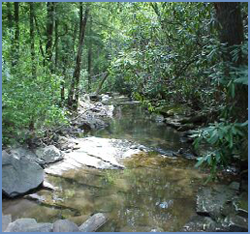
Helpful Links
 Introduction (TMDL Home)
Introduction (TMDL Home)
 Definitions
Definitions
 TMDL Program
TMDL Program
 EPA-Approved TMDLs
EPA-Approved TMDLs
 Proposed TMDLs
Proposed TMDLs
 Request For Proposals
Request For Proposals
 Watershed Management
Watershed Management
Introduction
Section 303(d) of the Clean Water Act establishes the Total Maximum Daily Load (TMDL) program.
A TMDL is a study that:
- Quantifies the amount of a pollutant in a stream,
- Identifies the sources of the pollutant, and
- Recommends regulatory or other actions that may need
to be taken in order for the stream to cease being polluted.
Some of the actions that might be taken are:
- Re-allocation of limits on the sources of pollutants documented as impacting streams. It might be necessary to lower the amount of pollutants being discharged under NPDES permits or to require the installation of other control measures, if necessary, to ensure that water quality standards will be met.
- For sources the Division does not have regulatory authority over, such as ordinary agricultural or forestry activities, provide information and technical assistance to other state and federal agencies that work directly with these groups to install appropriate Best Management Practices.
TMDLs can also be described by the following equation:
TMDL = sum of nonpoint sources + sum of point sources + margin of safety
The Division of Water Pollution Control has structured monitoring and
permitting activities on a rotating watershed basis. In keeping with this
approach, Tennessee is developing TMDLs on a watershed basis, with each
watershed examined at the appropriate time in the five-year watershed
cycle.



